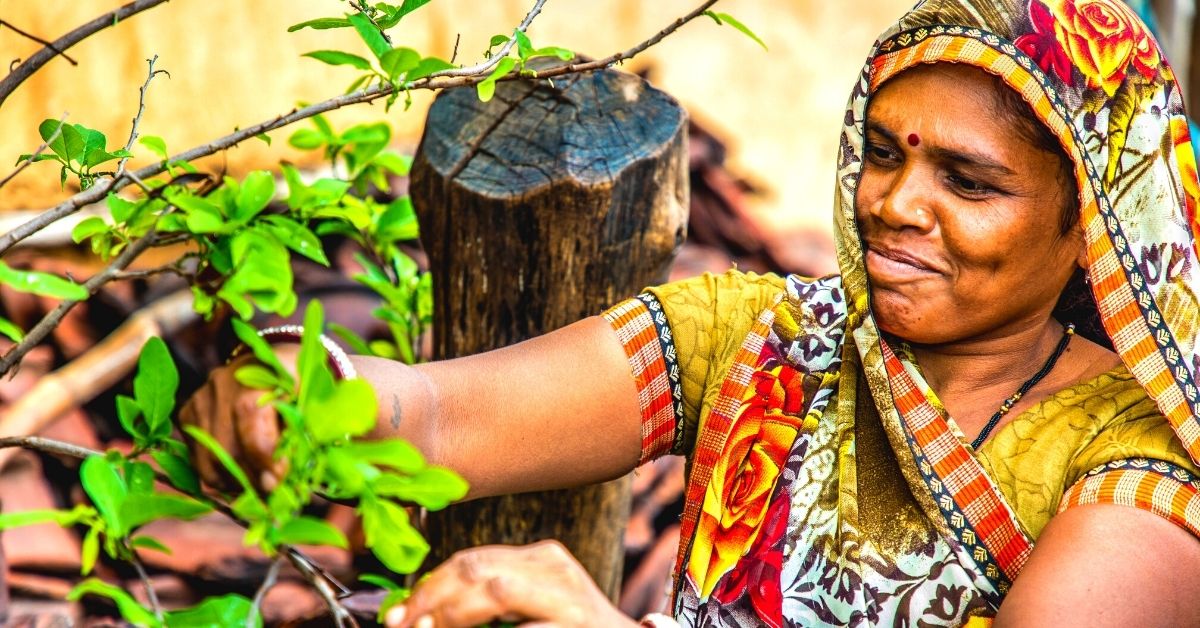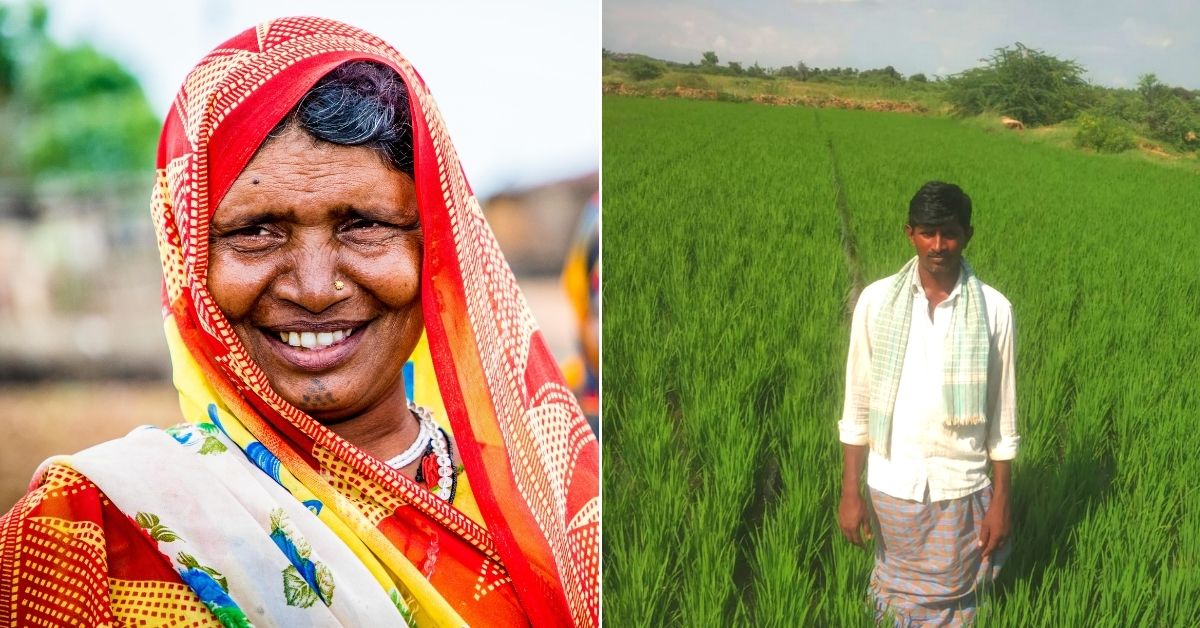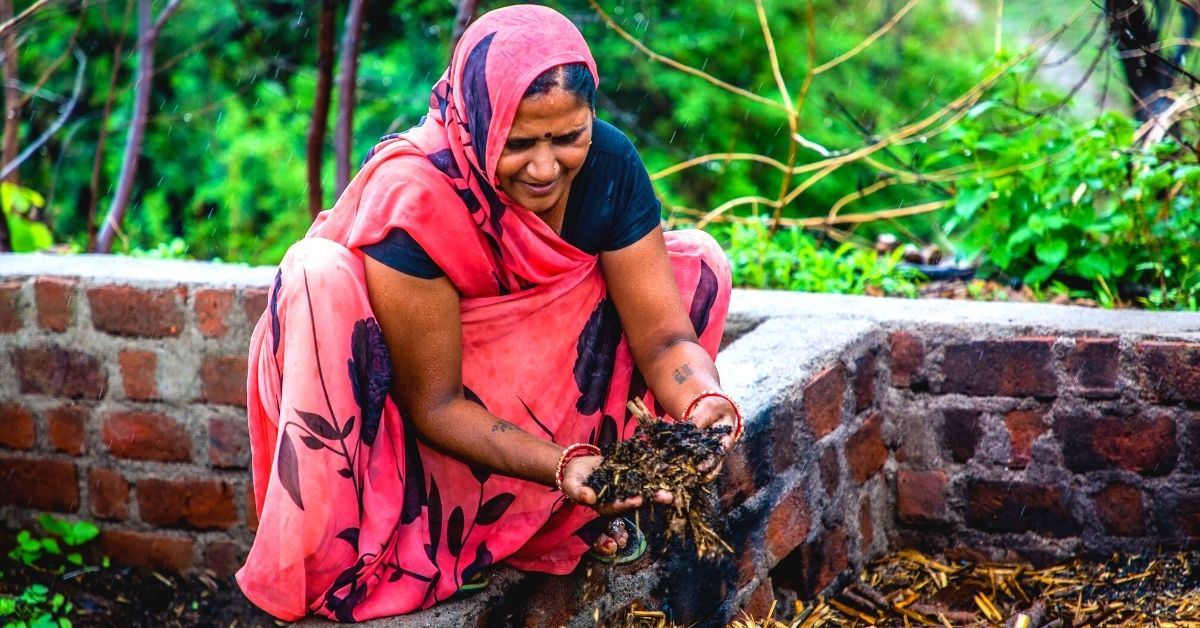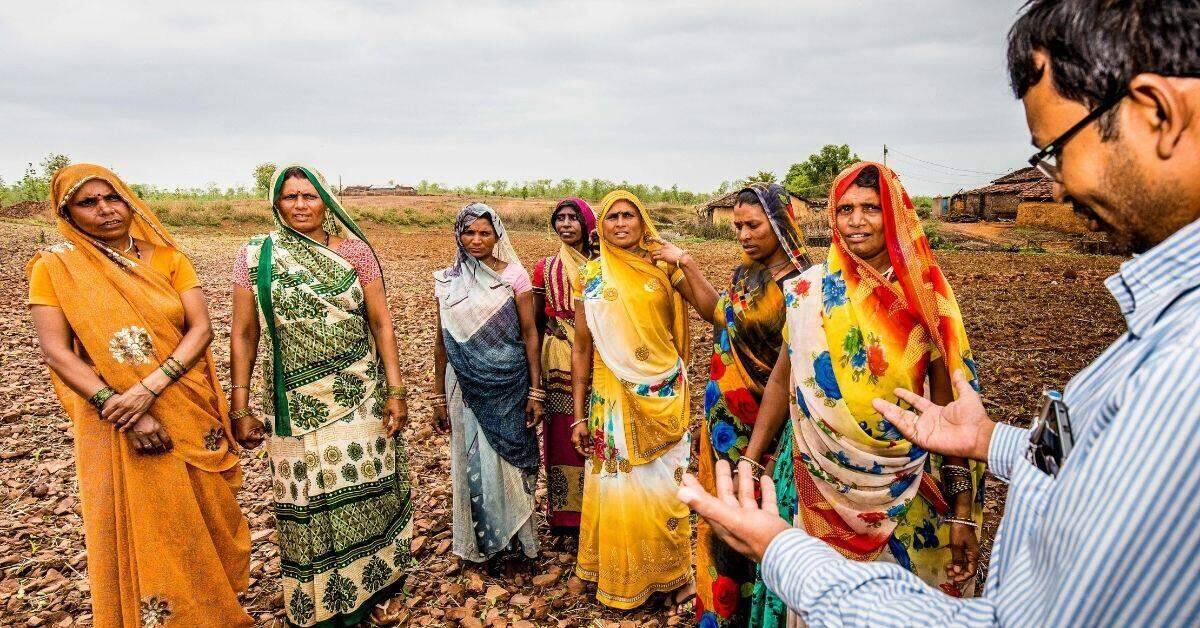Bengaluru Venture Helps 1 Lakh Farmers Sell Pesticide-Free Produce, Earn 20% More
In association with farmer producer organisations (FPOs), civil society and NGOs, Safe Harvest works with 100,000 small and marginal farmers who don't use chemical pesticides to grow organic produce.

Pesticide-free farming isn’t novel or new to India. For years, marginal (cultivating agricultural land up to 1 hectare) and small farmers (having less than two hectares of land) in this country have practiced it. But despite the superior quality, their produce often gets clubbed with conventional produce as there is no separate category for pesticide-free produce in India as yet. (Image above courtesy Safe Harvest)
Enter Safe Harvest Pvt Ltd, a venture established in 2009, which in association with farmer producer organisations (FPOs), civil society and NGOs works with 100,000 small and marginal farmers from some of the remotest parts of India. It helps put into practice the Non-Pesticidal Management (NPM) system of agriculture and connects them to consumer markets.
“For instance, one of our long-standing partners is Samaj Pragati Sahayog (SPS), a grassroots organisation based in the predominantly tribal district of Dewas in Madhya Pradesh, and working with over 4,000 tribal women farmers. Another of our partners is the Aga Khan Rural Support Program, working with smallholder farmers in remote areas of Gujarat (Netrang and Dangs),” Rangu Rao, CEO Safe Harvest, tells The Better India.
What Safe Harvest claims to do is give their produce “the recognition it deserves”, and helps connect the farmers to consumer markets. The venture further claims that farmers practicing NPM and working with Safe Harvest earn approximately 20% more than farmers cultivating conventionally. But how?
Besides assisting them in adopting this healthier NPM practice, the venture also ensures the collection of the produce at the farmgate and works with banks and NBFCs (Non Banking Financial Companies) to help them in their procurement operations.
Going further, Safe Harvest also claims to organise rigorous tests over 120 pesticides to ensure consumers receive a pesticide-free product. “We do minimal processing which helps retain all the nutritional elements (pulses, brown rice, unpolished millets, khandsari sugar, whole wheat flour etc), with no added additives and no blending,” he adds.

Pesticide-Free Produce
“A majority of the farmers organisations like FPOs and NGOs we work with have been practicing traditional methods without the use of any synthetic pesticides, etc for years. The knowledge of the same has been passed down through decades, if not centuries, of practice. So NPM as a method, in essence, builds on and promotes these traditional practices. However, in 2005, eight civil society organisations came together to make the interventions more formal and structured (working out standards, protocols, etc). In 2009, when the operations on ground became more consolidated, these organisations perceived a need to market this sustainably grown produce to enable the smallholders to receive a premium, thus giving birth to Safe Harvest,” says Rao.
One of the fundamental facets of NPM is the use of bio-repellents/pesticides, which are often more effective than chemical pesticides. They help control and prevent pests, while chemical alternatives aim only at control. So, while the natural pesticides repel bad pests, the chemical ones kill all pests, leading to an imbalance in the ecosystem. These bio-pesticides comprise ingredients such as neem, datura and custard apple leaves, etc. In addition to bio-pesticides, farmers also set up pheromone traps and bird perches to repel pests.
“The practice of NPM in Indian agriculture involves employing different strategies before, and during the crop cycle to ensure that pests are effectively managed and that crop health is maintained. Before sowing, our farmers choose pest-resistant varieties of crops that are suitable and are well adapted to the local agro-ecological systems. We promote intercropping and mixed cropping to ensure that the overall health of the crop eco-system is enhanced. We encourage crop rotation to break the cycles of harmful insects and weeds,” explains Rao.
They recommend planting of trap crops and border crops that serve the dual purposes of staving off harmful pests, while also reducing the risk of contamination due to pesticide drift from adjoining fields. There is also an emphasis on improving the soil health by increasing the organic matter (by applying compost, green manure, etc), and thereby increasing the natural defences of the crop ecosystem.
“There are broadly two phases of pest management during the crop season. The first phase includes deploying surveillance and prevention measures such as placing pheromone traps to understand the intensity of pests. This phase also includes placing bird perches (on which birds are able to rest, look out and attack harmful insects), conducting weeding at important junctures of the crop cycle and segregating and removing disease-ridden plants,” he explains.
The second phase of pest management happens when farmers realise that there is an onset of pest attack, or if they notice that yields may not reach the expected levels.
In this phase they are encouraged to spray locally made bio-pesticides. To improve yields, they apply nutrients/organic matter and naturally prepared growth promoters.
The benefits of adopting NPM are plenty.
It has been four years since Basumati Daryav, a 45-year-old farmer from Laxminagar village in Dewas district, Madhya Pradesh, adopted NPM on her 1.23 acres of land. “I grow Tuar (Red Gram). Earlier, I used to apply Dawa (synthetic pesticides) and was very scared of them. I used to spend Rs 200-300 for a litre of pesticides, though the efficiency of these pesticides began to drop over the years. This drove me into debt. Members from Samaj Pragati Sahayog visited my farm and told me to try out NPM on a part of my land at first, which I did. I noticed that there was no significant drop in the yield as compared to the past,” she says.
Chandramappa, a 39-year-old farmer from Bhommanhalli village in Raichur district, Karnataka, began practicing NPM about seven years ago. He says, “I started practicing NPM in 2014 through the Janara Samuha Mutual Benefit Trust (a local community-based organisation with over 7200 rural women). JSMBT has formed an NPM farmers group in our village and trained us on NPM paddy cultivation. The NPM method has helped me maintain additional savings of Rs 3,000 per acre due to reduction in the cost of nutrient and pest management. I also use less water to grow my crop. I grow paddy, ground nuts and onions on my 2.5 acres of land.”

Besides, farmers are also able to save on water and electricity. Most commodities that Safe Harvest procures are grown in drylands and rainfed areas, where irrigation facilities are limited. However, in the case of paddy for example, the organisation that Safe Harvest partners with also works on water management, which is integral to their NPM program.
“Whereas earlier, farmers would flood their fields and have about 4-6 inches of standing water, they now maintain only 1-2 inches of water, which significantly cuts down on the water used to grow the crop, and consequently increases their savings on electricity used for irrigation. Most organisations that Safe Harvest partners with work on interconnected thematic areas such as development of watersheds in tandem with promoting NPM agriculture. So water use and consequently electricity use optimization go hand in hand with NPM agriculture,” says Rao.
Marketing Their Produce
“While the specifics of water, electricity, and money differ from place to place, on average the farmers who practice NPM and market their produce through Safe Harvest have realised about a 20% increase in their net savings,” argues Save Harvest CEO Rangu Rao.
Rao explains that Safe Harvest directly procures produce at the farm gate, thereby eliminating the transportation costs for farmers (who, conventionally would have to take their produce to the nearest APMC Mandi), which is a significant reduction in the farmers’ expenditures.
“The commission costs at the Mandi that the farmers would have to pay are also eliminated due to this intervention. Moreover, we provide about 2-3% premium on the prevailing Mandi prices for the farmers’ produce at the farmgate. In some cases, we also provide bags for packing, the cost of which would otherwise have to be borne by farmers. They are able to save more due to reduced input costs following the elimination of synthetic pesticides. For instance, Safe Harvest’s paddy growing farmers based in Raichur, Karnataka are able to save anywhere between Rs 2,500-5,000 per acre by practicing,” explains Rao.

Farmers Producer Organisations (FPO) are also benefited by their association with Safe Harvest as they are able to avail low-interest loans from Non-Banking Financial Corporations, that, in turn, they invest to enhance their value-addition capacities, that further the prices they realise for their produce. “For example, RRPPCL (Ram Rahim Pragati Producer Company Limited, a producer company promoted by SPS), now directly supplies milled and packed Wheat Flour to Safe Harvest, whereas earlier, they were only supplying whole wheat,” he adds.
As Basumati says, “I took my produce to the local Seth (moneylender), but I found that the price he quoted was low. One of the Mitaans (field extension officers) of SPS suggested that I sell the produce to RRPPCL (the farmer producer company promoted by Samaj Pragati Sahayog). The company collected the produce from my house and I was able to save more because I did not have to spend money on labour and transportation costs. I now practice NPM on my entire land and I’m able to eat and feed my family poison-free food. I am also a member of Asha Pragati Samuh (the local Self Help Group) and we meet often to improve our cultivation practices.”
Meanwhile Chandramappa claims, “Safe Harvest helped us in marketing our NPM produce through Farm Gate Procurement services. Their marketing system has benefited a lot due to transparency on weighing of produce, zero commission and guaranteed payment on time.”

Not Organic
Is it financially viable for all farmers, particularly small and marginal, in India to go completely organic? Is the ultimate objective of Safe Harvest to go organic?
Rao doesn’t answer in the affirmative. He explains, “The process of organic certification is expensive, bureaucratic and is out of reach for a large majority of small and marginal farmers. Moreover, there is a conversion period of three years, during which, there is a significant reduction in the yields which most smallholders cannot afford, and which consequently may be unviable for these farmers. The produce during this period is also not recognised as organic, thereby providing no window to distinguish it from ‘conventional’ produce.”
NPM on the other hand advocates the elimination of synthetic pesticides. There is no conversion period required. “Further, there is no major drop in yields and the farmers are able to adopt it much more easily. NPM also couples its no synthetic pesticide usage rule with other immensely beneficial practices such as crop rotation, mixed-cropping, intercropping and maintaining soil health. These practices, while enhancing the health of the environment, also diversify the risks associated with mono-cropping,” he adds.
Safe Harvest tests its products in FSSAI accredited laboratories as per Jaivik Bharat standards. If a compound reports levels of residue to be Below level of Quantification (BLQ) then as per given standards it’s to be understood as zero. However, Jaivik Bharat standards are not about zero for all pesticide compounds.
But as Rao goes on to assure in conclusion, “Safe Harvest ensures that its partner organisations practice pesticide-free agriculture. However, there could be inadvertent contamination due to wind-drift and water from contiguous farms that practice conventional agriculture. The stringent testing at various stages of the supply chain eliminates this risk and ensures that Safe Harvest products are pesticide-free and are absolutely safe to consume.”
(Edited by Yoshita Rao)
Like this story? Or have something to share? Write to us: [email protected], or connect with us on Facebook and Twitter.
If you found our stories insightful, informative, or even just enjoyable, we invite you to consider making a voluntary payment to support the work we do at The Better India. Your contribution helps us continue producing quality content that educates, inspires, and drives positive change.
Choose one of the payment options below for your contribution-
By paying for the stories you value, you directly contribute to sustaining our efforts focused on making a difference in the world. Together, let’s ensure that impactful stories continue to be told and shared, enriching lives and communities alike.
Thank you for your support. Here are some frequently asked questions you might find helpful to know why you are contributing?


This story made me
-
97
-
121
-
89
-
167











